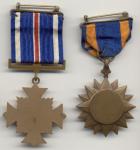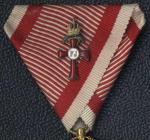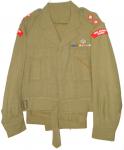-
Posts
4,908 -
Joined
-
Last visited
-
Days Won
97
Content Type
Profiles
Forums
Blogs
Gallery
Events
Store
Everything posted by Dave Danner
-
The Order of Oranje-Nassau had the white stripe, but the Order of the Golden Lion did not. It was yellow with the narrow blue edge stripe. However, almost every German recipient of that order appears to be royalty, with a first class award. If the separate ribbon bar Tim mentioned goes with it, the ribbon bar might be a pre-war KO4, Centenary, WF3b/WF3a, MG3. The the wartime medal bar added the EK2 and the mystery medal. I agree a Swedish Sword Order seems most likely, but I can't find a candidate either. I only can find one peacetime WF3/MG3 combo with a wartime WF3aX I can't rule out due to having other awards - Rittm. Kurt Freiherr von Senden-Bibran of KR 5. However, I can't find any evidence of a KO4 or the Swedish order. Recalled Maj.a.D. Hans Freiherr von Werthern had the prewar KO4/Centenary/WF3b/MG3 combo, as well as a wartime EK2 and WF3aX, but (1) no Sword Order and (2) he did have an Italian Order of the Crown (JK5), which should be there. I am left to conclude that the WF3aX doesn't belong. The EK2 might be the only wartime award.
-
I have now gone through the Kriegsrangliste entries of well over a thousand Meiningen-born Bavarian enlisted soldiers, and have found that: - about 1/4 have no decorations - another 1/4 or so have only a single decoration, either an EK2 or a Bavarian MVK or a SMM - another 1/4 or so have decorations from two states, usually an EK2 and MVK or an EK2 and SMM, occasionally an MVK and SMM - another 1/4 have all three: EK2, Bay. MVK, and SMM (plus perhaps other Bavarian awards or an EK1) - so far, only one has more than three states I still haven't found Rick's elusive Prussia/Bavaria/Baden/Meiningen combo. For that matter, I also haven't found my own elusive Prussia/Bavaria/Meiningen/Austria-Hungary/Bulgaria officer combo (though many other officers do have more combinations than the NCOs and enlisted men). The one I did come across is an aviator: Franz Hey, a Vizefeldw. u. Offz.-Stellv. who served from 1912 to 1918 with various flying units. He received the pilot's badge, EK1 & EK2, SMM, a Bavarian MVK (but it doesn't say what grade), and an unusual one, the Austro-Hungarian Silver Merit Cross on the ribbon of the Bravery Medal.
-
Officially, the MVM was supposed to be a lesser award: According to the 1915 regulations, "Die Fürstlich Lippische Militär-Verdienstmedaille mit Schwertern kann verliehen werden an solche Unteroffiziere und Mannschaften, die infolge einer leichten Verwundung oder einer im Feld entstandenen Krankheit dienstuntauglich geworden und nicht im Besitze des Eisernen Kreuzes oder dazu eingegeben sind." So it was apparently intended for soldiers wounded or rendered unfit for service due to illness in the field, who did not have the Iron Cross or weren't recommended for it. The Kriegsverdienstkreuz, by contrast, originally was supposed to require award of or recommendation for the Iron Cross, or other excellence in combat ("Für die Verleihung des Kriegsverdienstkreuzes ist Bedingung, daß der Vorzuschlagende das Eiserne Kreuz zweiter Klasse besitzt, von seinem Truppenteil hierzu eingegeben ist oder sich sonst besonders hervorgetan hat."), A March 1917 regulation said that if an MVM recipient later received the KVK, he was supposed to return the MVM ("Bei Verleihung des Kriegsverdienstkreuzes ist jede etwa vorher verliehene Militär-Verdienstmedaille an das Militärkabinett zurückzureichen."). However, there are numerous examples of this not occurring, so apparently this regulation wasn't followed in practice.
-
Another strange one: Lt. Herbert Koppenhagen received the Golden Bravery Medal on 9 December 1915, and the Iron Cross 2nd Class two weeks later, on 20 December. The actual acts for which he received the medals must have been earlier, because he is listed as receiving them as a Fähnrich in 23. bay. IR, but he was promoted to Leutnant on 25 October 1915 (his Patent was later, 22 March 1916). He gets the Iron Cross 1st Class on 28 March 1917 and the Black Wound Badge on 25 June 1918. So unlike your guy he does get another higher award in the EK1, but: (1) he's an officer, but no MVK (common for officer candidates though maybe the Golden Bravery Medal trumped that) and no MVO, despite being an infantry platoon leader at Verdun. (2) did I mention he was from Sachsen-Meiningen, born in Unterneubrunn and residing in Schleusingen, Kreis Hildburgshausen? No SMM or SMK either.
-
Rank is big factor, too. A large percentage of Silver Bravery Medal recipients were NCOs. Naturally, they would be more likely to have a DA. But they were also more likely to have an MVK, since the MVK wasn't just for acts of bravery but also military merit, and successful combat leadership was a big part of military merit. But a private could have a single spectacular act of bravery and get the Bravery Medal, and then otherwise fade back into obscurity as just another grunt. He's already got a medal more prestigious than the MVK anyway. What surprises me more than the lack of an MVK is that Pion. Stark served throughout almost the entire war and apparently never got promoted.
-
No need to dig further. Schießplatzmeister's #3 is correct. The point of the exercise was how similar an MMJO/MVO combination might be to a TM/MVK combination. The silver swords could be either for an MVO 4th Class or an MVK 2nd Class, and the MMJO and Bravery Medal ribbons were the same. And of course the SMK and SMM also used the same ribbon, so no help there. As for the other two Bavarian ribbons, a 1905 Jubilee Medal or 1911 Prinz-Regent-Luitpold-Medaille usually indicates an officer, since only certain NCOs were eligible for either medal. The DA could be an officer's 24, but that wouldn't really fit with only a 4th Class MVO, so more likely for an active NCO or a Landwehr officer/NCO. so... Arthur Emil Rudolf Hädicke - Born 5 November 1885 in Camburg, Kreis Saalfeld, Sachsen-Meiningen - Entered service 18 October 1906 in 5/10. bay. FAR - Gefreiter and Unteroffizier promotions in 1908, then Sergeant in 1912, Vizewachtmeister in 1913, Offizier-Stellvertreter in 1916. - Served in the war with several different Bavarian FARs and RFARs - EK2 (9.10.14), BsMV (5.11.15), BMV5bX (20.3.16), SMM (15.12.15), BPRLM, BD1, VAs (30.6.18) As an NCO, he was a Kapitulant, so I assume that's why he was eligible for the Prinz-Regent-Luitpold-Medaille. I've been trying to find some elusive Bavarian/Meiningen combinations, without luck, but while looking I came across this guy, who seemed interesting. Many of the Bavarian SMM recipients got only an SMM and maybe an EK2, while most also got Bavarian awards like the MVK and DA. But so far this is the only Meininger with a Bravery Medal I've come across.
-
The precedence is my mistake, not relevant to the original question. I actually wasn't sure how a Bavarian would place the non-Bavarian awards - after all Bavarian or after war awards but before other Bavarian. I'm still not sure actually, as I've seen it both ways. So I used later precedence, but without an FKE. Here is a revised version: Regarding the websites, if I manage to get them back up, I will have to extensively revise and update the MMJO bios now that the Bavarian personnel files are available. Regards, Dave
-

Full Wrap Brooch Styles on US Awards
Dave Danner replied to Tim B's topic in United States of America
I also have a boxed, slot-brooch Silver Star similar to Tim's. It is a Bastian Brothers Aug. 9. 1943 contract. For additional reference, here are a DFC and Air Medal with the wrap brooch in question: -

Full Wrap Brooch Styles on US Awards
Dave Danner replied to Tim B's topic in United States of America
This one, by contrast, is re-ribboned. It is an unnumbered DSC, by the style and quality a World War II-era example which probably was originally on a slot brooch, but re-ribboned on a wrap brooch. -

Full Wrap Brooch Styles on US Awards
Dave Danner replied to Tim B's topic in United States of America
The style of full wrap brooch in question was used in issued Silver Stars. Below are two Silver Stars from my collection: On the left N.S. Meyer, Inc., Purchase Order No. 1231, Aug. 16, 1943 Phila. Q.M. Depot On the right: Serial No. 104921 Medallic Art Co., Purchase Order 10408-Jan. 20, 1943 Phila. Q.M. Depot I also noted that the N.S. Meyer example is much thicker than the Medallic Arts piece, but less polished. It looks a bit like the one you showed above. -
-
-
-
-
Actually, I'm not sure even that matters. The way the auction is set up, you would have to outbid everyone interested in the various neck and breast badges alone before you even got to the lots which are most attributable, the medal bar (lot 0046) and the document group (lot 0047). Even if you had the resources and the desire to keep the group together, you would have to be deterred by the fact that you would have a series of potential fights long before you had any chance of knowing it would pay off. You would budget your fight on how much it was worth for the entire group, and how much room you had in each piece, but the guy who only wants a BMV2XmSt or a RAO2X only has to know how much he's willing to spend on that. And there are plenty of so-called collectors who don't care about Zoellner or the history, but only about how much the big pretty enamel ones are worth. If they put the medal bar and document lots first, maybe one person could keep it together. If I already won those, I would feel slightly more comfortable in a bidding war for the others, but if I didn't even know if I would get the medal bar and documents, how much would I be wiiling to fight for what is otherwise just another EK1 or even a really nice RAO2X.
-
In keeping with Rick's discussion of how common awards can sometimes make for uncommon combinations, I present this medal bar. I got this bar in 2007 at Gunzenhausen because it looked nice, but I didn't give any though to research at the time. After all, it's just Prussia, Bavaria and Württemberg, three of the largest states of the German Empire. And there were some 3000 awards of the Bavarian Militär-Verdienstorden 4. Klasse mit der Krone und mit Schwertern (BMV4XmKr) and over 5000 awards of the Ritterkreuz 2. Klasse mit Schwertern of Württemberg's Friedrichsorden (WF3bX). But when I got back home, something occurred to me. The BMV4XmKr was normally awarded to majors. Captains and lieutenants got the BMV4X without the crown. But the WF3bX was awarded to lieutenants, while majors and captains got the WF3aX. However, as the war progressed, a number of BMV4XmKr were awarded to Bavarian captains and lieutenants who had earlier received the BMV4X. Also, there is no long service or 1911 Prinz Regent Luitpold Medaille, so the recipient was likely a junior officer as the WF3bX would indicate. My main source for Württemberg awards to Bavarians is Erhard Roth's volume on non-Bavarian awards to Bavarians. I checked those against recipients of the BMV4XmKr, and eliminated those with other known awards such and the Prinz Regent Luitpold Medaille. As I noted back in 2007 in an earlier thread, at first I found one possibility - Lt.d.R. Heinrich Fichtbauer. Unfortunately, further research eliminated him, as he also received the Prussian House Order of Hohenzollern. I then found one other possibility, Ernst Ritter von Müller, but he only worked if his Military Order of Max Joseph was worn on the buttonhole, and not mounted on the medal bar. However, further research eliminated him anyway, as he was killed in action in 1917. ... Skip ahead several years to today. I just got access to the Bavarian personnel records on Ancestry.com and began searching for various people. One place I looked was for BMV4XmKr recipients who might have gotten the WF3bX but were missed by Roth because the award came late in the war and wasn't gazetted in the Verordnungsblatt des Königlich bayerischen Kriegsministeriums or other sources. And who do I find? One Lt.d.R. Ludwig Franz Dürr of bay. 4. IR, recipient of the Iron Cross 1st and 2nd Class, the WF3bX (W.F.5. m.Schw. in the Bavarian notation), and the BMV4XmKr. The BMV4XmKr replaced an earlier BMV4X, which itself replaced a Military Merit Cross 2nd Class with Crown and Swords received as a Vizefeldwebel u. Offziers-Aspirant. There is still a chance that he is not my guy. There might be someone else I missed with that uncommon combination. But out of hundreds of possibles I went through, he is the only match I found. So I think the odds are good on this one, if not 100%. :cheers:
-
Hi, Not really any good ones for Baden. The various grades of the Order of the Zähringen Lion were Baden's basic award for officers, but it was generally a one-time deal. A Baden officer might typically get his Zähringen Lion at roughly the same time as his Iron Cross 2nd Class and then that was it. If there were cases of an officer getting a lower grade of the Zähringen Lion early in the war and a higher grade later on, they were exceptional and I don't know of any. Baden's other main military award was the Militärischer Karl-Friedrich-Verdienstorden, but this was extremely rare, like the Pour le Mérite, with only 288 awards of the Knight's Cross of the MKFVO. Also, since awards of the EK to Badeners weren't separately published, I don't know the award dates for most. One I do know is the later General der Flieger Karl Friedrich Schweickhard. His EK2 came on 15.9.1914 and was followed shortly by the Knight 2nd Class with Swords of the Zähringen Lion on 3.10.1914. His EK1 came on 6.10.1915. He then received Baden's MKFVO on 14.6.1916. Another Prussian award, the Knight's Cross with Swords of the Royal House Order of Hohenzollern, came on 18.10.1917. He also got a Mecklenburg-Schwerin Military Merit Cross 2nd Class, but I've been generally leaving off awards other than the Prussian and home state, since that's what your question related to. Another aviator example, though, shows how complex this all is. Albert Dossenbach was a native of Baden, but when the war began the then-medical student enlisted and ended up in Füsilier-Regiment Nr. 90, a Mecklenburg-Schwerin regiment. He got the EK2 on 20.9.1914 and the EK1 very soon thereafetr, on 23.11.1914. Mecklenburg-Schwerin awarded him the Military Merit Cross 2nd Class on 15.9.1914, basically at the same time as his EK2, so apparently Baden felt no need to decorate him as well. All of these came as an enlisted soldier. He was commissioned a Lt.d.R. on 27.1.1915. Baden then got around to decorating him on 1.6.1915 with the Knight 2nd Class with Swords of the Order of the Zähringen Lion. He was still in a Mecklenburg regiment, and got the Military Merit Cross 1st Class on 29.9.1915. He then transferred to aviation in November 1915 and a year or so later, in rapid succession, got the Prussian House Order of Hohenzollern (28.10.1916), Prussian Pour le Mérite (11.11.1916), and Baden MKFVO (9.12.1916). He was shot down and killed on 3.7.1917. The only other example I have at hand is similar to Dossenbach and thanks to the research of Christoph Deruelle. Ernst Hischmann, a native Badener, did his initial military service in Baden's IR 114, but on mobilization in 1914, the Landwehr lieutenant was activated with Füsilier-Regiment Nr. 40, the regiment of the Hohenzollern principalities (but closely connected to Baden because of where it recruited). His first decoration thus came from the prince of Hohenzollern, the Honor Cross 3rd Class with Swords of the Princely House Order of Hohenzollern, on 1.10.1914. I can't find his EK2 date (maybe Christoph can recall), but his EK1 came on 9.11.1916, shortly after his Baden Zähringen Lion Knight 2nd Class with Swords on 19.6.1916. The Prussian House Order of Hohenzollern came on 31.10.1917, at about the same time as the Baden MKFVO on 3.10.1917. He was killed in action 18.7.1918. But these Karl-Friedrich knights were pretty exceptional. Most Baden officers would have gotten an EK2 and the appropriate grade of the Zähringen Lion, and then maybe later the EK1, and that's it. Regards, Dave
-
For some reason, when I merged the separate topics and deleted the duplicate post, it deleted the entire thread. I undeleted it and now I am bumping it in case anyone missed it in searching for new content. The only post-1867 Baden court handbooks I have access to are 1869, 1876, 1884, 1898, 1905 and 1913. 1884 is too early and 1898 may be too late. The closest match in 1898 is Maj. Karl Friedrich August Schmitt, Kommandant d. I. Gendarmerie-Distrikts. He had the four on the medal bar above, plus the 1897 Centenary Medal and the Romanian Order of the Star, Officer.



















